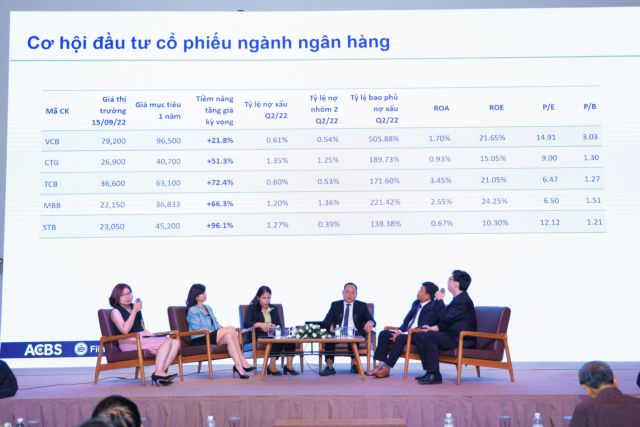 Economy
Economy


|
| Speakers at an investment conference in HCM City last week agree that securities remain an attractive asset class. — VNS Photo |
HCM CITY — Retail investors have been pulling money out of the stock market so far this year, but will return soon, according to analysts.
Đỗ Hồng Vân, head of the data analyst team, financial information division, Fiin Group, an integrated service provider of financial data, business information, industry research, credit rating reports and other data-driven analytics services, said, "Compared with other asset classes such as gold and real estate, stocks remain an attractive option.
“Retail investors have been sellers since April, but there a large amount of money is still in investors’ accounts."
According to data from securities companies, around VNĐ70 trillion (US$2.96 billion) was in investors’ accounts at the end of the second quarter.
"It is a very large amount compared to the recent trading of VNĐ10 trillion-VNĐ12 trillion a day, and is waiting for a favourable opportunity to return to the market," Vân told a conference organised by ACB Securities (ACBS) and FiinTrade in HCM City last week.
Vân said investments by retail investors increased sharply last year and this cash flow supported the market.
But since December 2021 they had tended to be cautious and reduced their investments, she said.
Among the main reasons for the recent poor sentiment among retail investors are that they are not seeing any “promising story” in the near future and the Government’s regulatory crackdown on certain companies to improve the market’s transparency has resulted in sharp price volatility, according to Vân.
But they are expected to return to the market this quarter and next.
According to attendees at the conference, sectors such as industrial real estate, electricity, animal husbandry, pharmaceuticals, dairy, and banking have positive growth prospects this year.
The power sector is expected to grow by 5.1 per cent in 2022 as consumption by the manufacturing sector increases after the COVID-19 pandemic.
Besides, the La Nina weather phenomenon is expected to last until early 2023, helping increase water storage in hydropower reservoirs, and the sector’s average full market price (FMP) in July and August was nearly 50 per cent higher than a year earlier.
Speaking about the industrial real estate sector, Nguyễn Bỉnh Thanh Giao, deputy head of the analysis department at ACB Securities, said though the stock prices of industrial real estate enterprises had experienced remarkable growth vis-a-vis the VN-Index in the three years since the CPTPP was signed, there would be still much room for them to rise thanks to the high profit margin and return on investment.
The sector was expected to grow by 49.7 per cent this year, she said.
“Foreign enterprises continue to flock into Việt Nam and rentals for land and ready-built warehouses and factories are expected to increase due to limited supply.
“Multinational corporations tend to choose smart eco-industrial parks with many utility services, standard wastewater treatment systems and logistics, and are willing to pay higher rentals, creating opportunities for businesses having large vacant lands.”
Industrial real estate businesses often have higher profit margins than those in the housing segment, which is facing many challenges.
They pay cash dividends regularly based on their high profit margins and ROE and bright development prospects, but their stocks’ liquidity is often low because their managements are usually tight-lipped and so do not attract investors’ attention.
Speaking about the banking sector, Cao Việt Hùng, head of the financial analysis division at ACBS, said the sector accounted for only 31 per cent of the market capitalisation but 44 per cent of the total profits in the VN Index.
It was expected to grow strongly this year based on supporting factors such as improved net interest margin thanks to an increase in lending interest rates amid tight credit and well-controlled cost of capital, he said.
Banks also had lower provision costs thanks to improved asset quality and larger capital buffers, and they were back to 1.4-1.5 per cent of outstanding loans, the same level as before COVID-19.
These would augur well for profit growth, he said.
Profit before tax for banks that ACBS tracks was forecast to grow by 45.2 per cent in the second half of 2022 and 34.6 per cent for the whole of 2022.
This stock group had an attractive valuation with a P/E of 9.5x and P/B of 1.7x, he added.
Experts also listed a number of sectors that achieved a breakthrough in profits in the first half of the year like residential real estate, steel, chemicals, seafood, fertilisers, garments, and logistics. — VNS




